Major Component Of Plasma Membrane
The Plasma Membrane
Cells closely control the exchange of substances in and out of the cell. Some substances are excluded, others are taken in, and still others are excreted – all in controlled quantities. Although the plasma membrane encloses the cell's borders, it is far from beingness a static bulwark; it is dynamic and constantly in flux. The plasma membrane must exist sufficiently flexible to permit certain cells, such as scarlet blood cells and white claret cells, to change shape as they pass through narrow capillaries. In addition to these more obvious functions, the surface of the plasma membrane carries markers which allow cells to recognize one another. This is vital equally these markers play a role in the "self" versus "non-self" distinction of the immune response.
Fluid Mosaic Model
In 1972, S. J. Singer and Garth 50. Nicolson proposed a new model of the plasma membrane. This theory, compared to earlier theories, all-time explains both microscopic observations and the office of the plasma membrane. This theory is called the fluid mosaic model. The model has evolved somewhat over time, but still best accounts for the construction and functions of the plasma membrane as we now understand them. The fluid mosaic model describes the structure of the plasma membrane as comprised of various components—including phospholipids, cholesterol, proteins, and carbohydrates—that are able to flow and change position, while maintaining the bones integrity of the membrane. Both phospholipid molecules and embedded proteins are able to motion laterally in the membrane. The fluidity of the plasma membrane is necessary for the activities of sure enzymes and transport molecules within the membrane.
Plasma membranes range from 5–10 nm thick. As a comparison, homo red blood cells, visible via calorie-free microscopy, are approximately 8 μm thick, or approximately 1,000 times thicker than a plasma membrane.
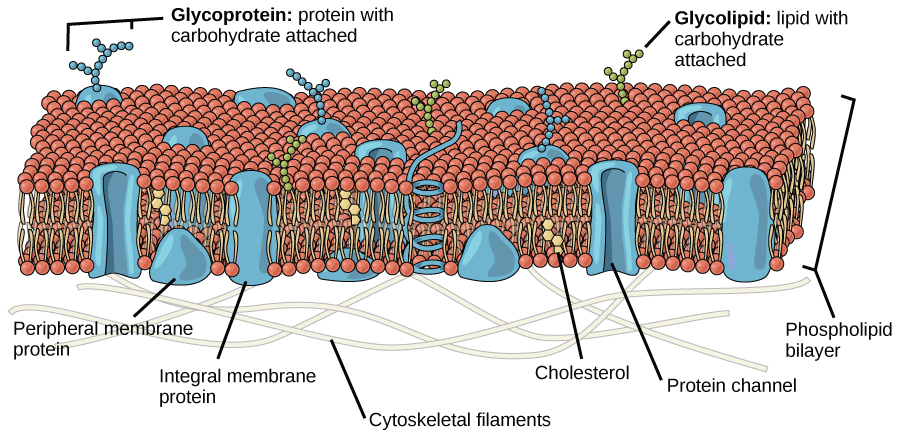
Components of the Plasma Membrane
The plasma membrane is made up primarily of a bilayer of phospholipids with embedded proteins, carbohydrates, glycolipids, and glycoproteins, and, in animal cells, cholesterol (Effigy 1).
Phospholipids
The chief cloth of the membrane is composed of ii layers of phospholipid molecules, and the polar ends of these molecules (which look like a collection of balls in an artist's rendition of the model) (Effigy two) are in contact with aqueous fluid both inside and outside the prison cell. Thus, both surfaces of the plasma membrane are hydrophilic ("h2o loving"). In contrast, the interior of the membrane, between its two surfaces, is a hydrophobic ("water fearing") or nonpolar region because of the fat acid tails. This region has no allure for water or other polar molecules.
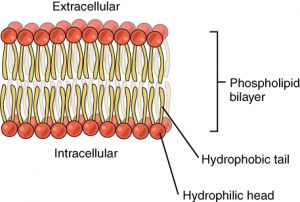
A phospholipid molecule (Figure 3) consists of a iii-carbon glycerol backbone with two fat acid molecules fastened to carbons i and 2, and a phosphate-containing group attached to the third carbon. This system gives the overall molecule an area described as its head (the phosphate-containing group), which has a polar character or negative charge, and an area called the tail (the fat acids), which has no accuse. The head can class hydrogen bonds, but the tail cannot.
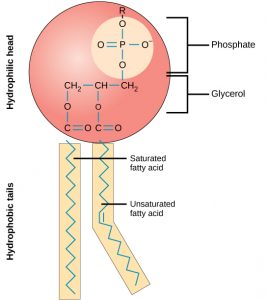
Proteins
Proteins make upward the 2d major chemical component of plasma membranes (see Figure 1). Integral proteins are embedded in the plasma membrane and may bridge all or role of the membrane (Figure i). Integral proteins may serve as channels or pumps to move materials into or out of the cell. Peripheral proteins are found on the exterior or interior surfaces of membranes, attached either to integral proteins or to phospholipid molecules (Figure 1). Both integral and peripheral proteins may serve as enzymes, as structural attachments for the fibers of the cytoskeleton, or as part of the cell's recognition sites.
The recognition sites on the plasma membrane are chosenreceptors, which are zipper sites for substances that interact with the cell. Each receptor is structured to demark with a specific substance. The binding of a specific substance to its receptor on the plasma membrane can activate processes within the interior of the cell – such as activating enzymes involved in metabolic pathways. These metabolic pathways might be vital for providing the cell with energy, making substances for the cell, or breaking down cellular waste material or toxins for disposal. Also, extracellular hormones and neurotransmitters demark to plasma membrane receptors which transmit a signal into the cell to intracellular molecules. Some recognition sites are used by viruses as attachment points. Although they are highly specific, pathogens like viruses may evolve to exploit receptors to gain entry to a cell by mimicking the specific substance that the receptor is meant to bind. This specificity helps to explain why human immunodeficiency virus (HIV) or any of the v types of hepatitis viruses invade merely specific cells.
Cystic Fibrosis is caused past a defect in an integral protein in the cell membrane which acts as a channel. The CFTR protein moves ions from one side of the membrane to another. When it is non functioning correctly, this causes very thick mucus to build upwardly in the lungs and digestive tract.
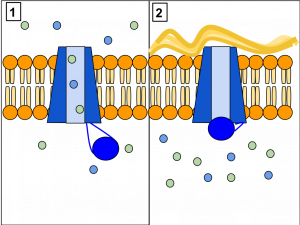
Carbohydrates
Carbohydrates are the third major component of plasma membranes. They are always found on the exterior surface of cells and are leap either to proteins (forming glycoproteins) or to lipids (forming glycolipids). These carbohydrate bondage may consist of ii–threescore monosaccharide units and may be either direct or branched. Along with peripheral proteins, carbohydrates course specialized sites on the cell surface that allow cells to recognize each other. These sites have unique patterns that allow the cell to be recognized, much the way that the facial features unique to each person allow him or her to exist recognized. This recognition function is very important to cells, as it allows the immune system to differentiate between trunk cells (called "self") and foreign cells or tissues (called "non-self"). Similar types of glycoproteins and glycolipids are establish on the surfaces of viruses and may change frequently, preventing allowed cells from recognizing and attacking them.
The carbohydrates that make upward glycoproteins are responsible for determining human A, B, O blood types. These glycoproteins are recognized past the immune system, which leads to incompatibility in claret types.
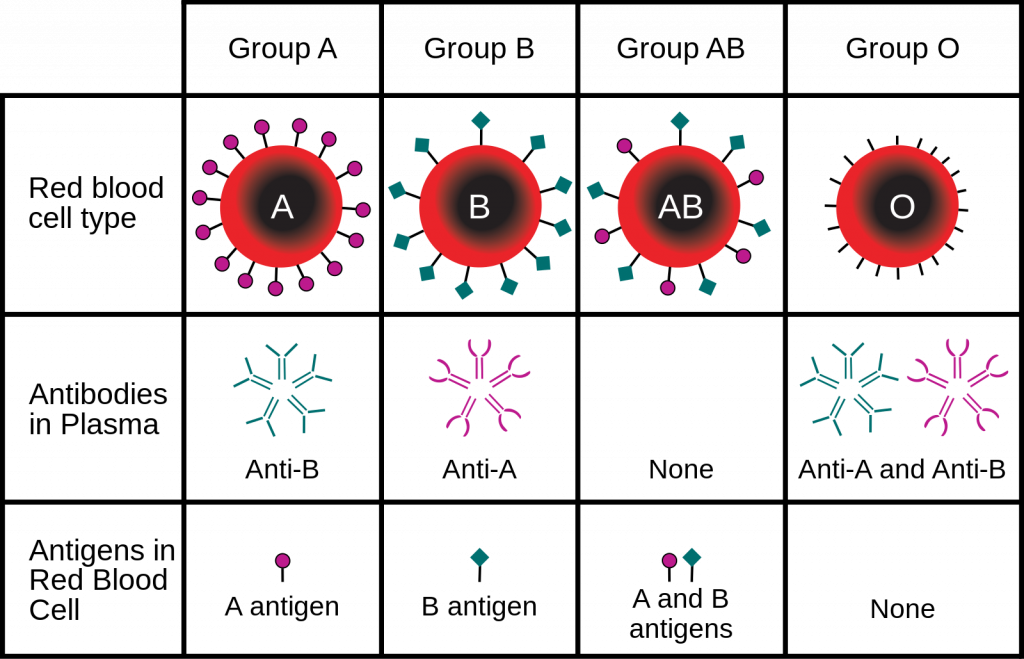
Membrane Fluidity
The mosaic characteristic of the membrane, described in the fluid mosaic model, helps to illustrate its nature. The proteins and other components that exist in the membrane can motility with respect to each other, rather like boats floating on a lake. The membrane is not similar a airship, yet, that can expand and contract; rather, it is fairly rigid and can outburst if penetrated or if a cell takes in besides much water. However, because of its mosaic nature, a very fine needle can easily penetrate a plasma membrane without causing information technology to burst, and the membrane will flow and self-seal when the needle is extracted.
The mosaic characteristics of the membrane explicate some but not all of its fluidity. There are two other factors that aid maintain this fluid characteristic. One gene is the nature of the phospholipids themselves. The construction of the fatty acrid tails in each phospholipid can make the membrane more dense and rigid, or less dense and flexible. The relative fluidity of the membrane is specially important in a common cold environment. A common cold surround tends to brand membranes less fluid and more susceptible to rupturing. Many organisms (fish are one example) are capable of adapting to common cold environments past changing the proportion of different types of fatty acids in their membranes in response to the lowering of the temperature.
Animals have an boosted membrane constituent that assists in maintaining fluidity. Cholesterol, which lies aslope the phospholipids in the membrane, tends to dampen the effects of temperature on the membrane. Thus, this lipid functions as a buffer, preventing lower temperatures from inhibiting fluidity and preventing increased temperatures from increasing fluidity too much. Thus, cholesterol extends, in both directions, the range of temperature in which the membrane is appropriately fluid and consequently functional. Cholesterol too serves other functions, such every bit organizing clusters of transmembrane proteins into lipid rafts.
References
Unless otherwise noted, images on this page are licensed under CC-BY 4.0 by OpenStax.
Text adapted from: OpenStax, Concepts of Biological science. OpenStax CNX. May eighteen, 2016 http://cnx.org/contents/b3c1e1d2-839c-42b0-a314-e119a8aafbdd@9.10
Major Component Of Plasma Membrane,
Source: https://openoregon.pressbooks.pub/mhccmajorsbio/chapter/the-plasma-membrane/
Posted by: danielssoing1993.blogspot.com


0 Response to "Major Component Of Plasma Membrane"
Post a Comment